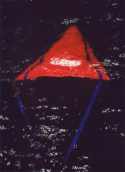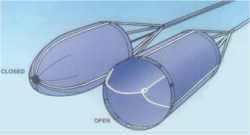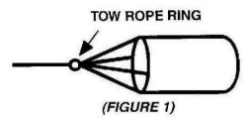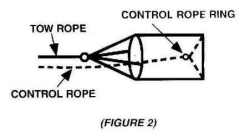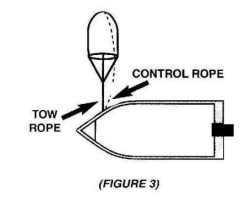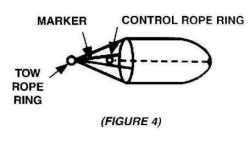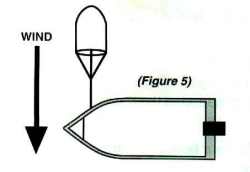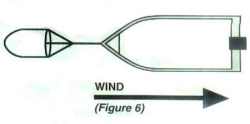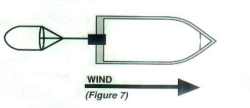
|
||||||||||||||

Drift Sock Harness Buoy Click here for more info and to order on line Church Tackles Walleye Planer Board 
Click here for more info or to order on-line Promotional Team Favorites Lodging food and more |
Taming the Waves of Big Lakes By Sam Anderson and Mark Martin The edge of a specific structure is a great place to start looking for spring walleyes. These edges form breaks, which almost act like barriers to hold fish a little longer to feed before they move on. These are physical boundaries between shallow food producing areas and deep water areas of the lake. Here schools of active walleyes meet concentrations of food and often this is a prime fishing area. By fishing the edges of weeds, drop-offs and structure like rocks, you will increase your chances of finding a funnel point where fish concentrate. These spots vary but are based on factors like: water temperature, availability of baitfish, oxygen, light level, structure and schooling tendencies. Success rests with proper presentation. Once you have located the edge and fish, the next step is to entice them to bite. Your bait presentation will depend upon the specific edge that you have selected. If the walleyes are directly below and concentrated on a physical edge you can backtroll a livebait rig, jig, or use a bottom bouncer rig, keeping the bait among the fish you see on thedepthfinder. If you find the fish strung out along the edge, keep the bait moving
and they will bite. If they're clumped up in one spot, hover over them
and vertically jig them.
The Magnum Series Drift Control Drift Sock is designed for use in the most extreme angling conditions. One-inch Nylon straps offer added support. The unique flotation device and bottom weights provide for faster deployment and prevents rotation when it enters the water. Durable, coated Rip-stop Nylon stops the drift sock from pulsating; therefore, creating more drag than other drift socks of the same diameter. Wind also has an effect on light penetration. The wind creates waves, and waves cut down on light penetration. That's why you'll find walleyes on a shallow reef on a bright day if it's windy. Take the same reef on a bright, calm day, and frequently it will be devoid of fish.Mark Martin said; "I generally start looking for walleyes on the wind-blown side of the lake, and the wind-blown side of a structure. Walleyes will usually be most active on the side of the lake or reservoir that the wind is blowing into because that's where light penetration is reduced. On a given piece of structure the same will hold true with baitfish being disorientated because of wave action. This is a key area, because the predators will congregate at the outside edge and feed on the baitfish. However, keep in mind that a good walleye structure that is not windblown will still be better that a poor walleye structure that is not windblown." Walleyes are opportunistic fish and will go where the meal is the easiest to catch. "There are some wind directions that I prefer over others, "Martin went on to explain. "It seems that north, northeast, and northwest winds can have detrimental effect on fishing success. They usually indicate a coming change in weather. Winds coming from the northwest are a good indication that a cold front is pushing across your favorite fishing hole. In the spring and fall this usually turns the fish off and the bite is very slow." Winds from the south or southwest are frequently good fishing winds. They bring warmer air, which can be a good deal in the spring and fall. They are commonly known indicators of stable weather conditions.As I mentioned before boat control is always a problem in the wind. With a little practice and a drift sock you can control your boat even on the toughest structure.
controlled with Drift Control drift socks. When using Drift Control drift socks in this manner, the boat is positioned perpendicular to the wind, and the socks are thrown over the side. The bowmount can be used to move the boat forward or backward to follow the breakline as you slowly drift along. Mark Martin believes that you should maintain boat control in the bow even in the toughest conditions. "You can throw out a Magnum Series Drift Sock and shorten the length of the tow line so you keep you bowmount in the water at all times." "If you are slipping along a breakline you can step on your bowmount and close the distance to the drift sock on every other wave." Martin went on to explain, that if you use this approach you will be presenting the bait in a vertical manner, rather than dragging the bait. In fact, at Chamberlain South Dakota Martin confesses, "when faced with
fishing high winds in a tournament I tied off the Magnum MS -150 off my
Ram mounts on my bow rail and a Magnum MS -100 off the stern, with a Tournament
Series in the mid-ship area. Now that gave me the control I needed to stay
at the depth the fish were at on the contour.""Believe me you will feel
more strikes and boat more fish if you can keep the bow down in the water,"
said Martin.
|
|||||||||||||
|---|---|---|---|---|---|---|---|---|---|---|---|---|---|---|
